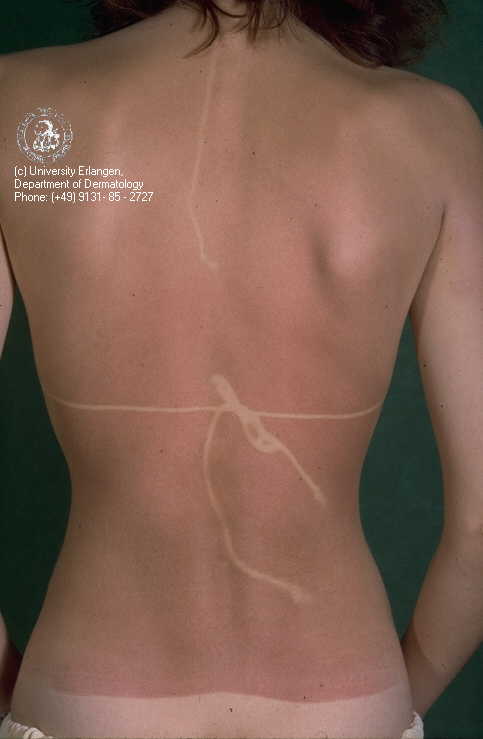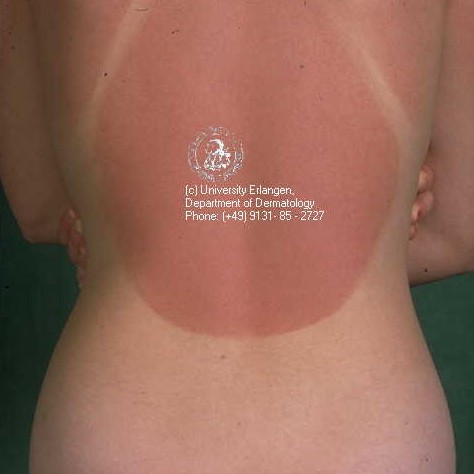|
Sunburn and your sunburn history
What is a sunburn?
A sunburn is your skinís response to overexposure to UV radiation. The skin turns red, becomes hot, and painful. A severe sunburn may even result in swelling and/or blistering. The length of time that will cause such reactions varies from person to person. Dark skin helps protect your skin from such a reaction through a larger amount of melanin which absorbs damaging solar radiation. Fair skin contains a smaller amount of melanin and therefore burns more easily and is more susceptible to damage. A tan in a light skined person is a sign of sun damage and the skin trying to prevent further damage.
Why do you peel after a sunburn?
Peeling after sunburn is your bodyís way of getting rid of damaged cells. This is necessary because cells damaged by the sun are at risk of "losing control" and becoming cancer. Due to this danger, all damaged cell are instructed to commit suicide by repair mechanisms within these cells. This mass suicide of cells results in whole layers of damaged skin peeling off, to be replaced by other cells underneath those layers.
What is the big deal if the damaged cells are shed anyhow?
The problem is that the damaged caused by UV light is a "double whammy". In the layers below, the repair mechanisms themselves may be damaged by the UV rays, which prevents the cells from committing suicide in the future. You do not even have to have sunburn for this kind of damage to occur. Skin damage caused by the sun is accumulative. Long term, daily exposure to sunlight adds up.
|
 |
 |
Is your history of sunburn important when it comes to your risk of getting skin cancer?
Regardless of your skin type, you should avoid long periods in the sun. Your risk of getting skin cancer increases depending on the amount and severity of sun exposure. Childhood is one of the most vulnerable periods of our lives and if you were in the sun often as a child or young adult, you should pay special attention to your skin. This is especially important to know if you have children. Sunburn at an early stage in their life can have dire consequences that may not be apparent now. Make sure that your children know about the dangers (knowledge is the one of the best weapons).
Can my medications make it worse?
If you are taking medication, you might be at increased risk. Some medications can cause your skin to be extremely sensitive to sunlight. It is important to know which medications can cause an increase in photosensitivity. If you are not sure, or have any questions, please contact your doctor or pharmacist.
|
 |
 |
| Brand Name |
Generic Name |
Therapeutic Class |
| Motrin |
ibuprofen |
NSAID, antiarthritic |
| Crystodigin |
digitoxin |
antiarrhythmic |
| Sinequan |
doxepin |
antidepressant |
| Cordarone |
amiodarone |
antiarrhythmic |
| Bactrim |
trimethoprim |
antibioti |
| Diabinese |
chlorpropamide |
antidiabetic (oral) |
| Feldene |
piroxicam |
NSAID, antiarthritic |
| Vibramycin |
doxycycline |
antibiotic |
| Phenergan |
promethazine |
antihistamine |
More Information: US FDA Consumer Magazine
I have a sunburn already, what should I do now?
You have a sunburn (even after taking some precautions) - what sould you do now? First of all, you should take care of the cause of your problem, get out of the sun immediately. Try to cool the exposed areas with a cooling gel, after-sun lotion or water. Avoid fatty creams, they prevent the skin from cooling and may make the situation worse. The sunburn will reach its maximum intensity between 12 and 24 hours after sun exposure. You should avoid sun on this area for the next couple days.
If you have a severe sunburn, with or without blistering, you should not hesitate to see a doctor or dermatologist.
|
